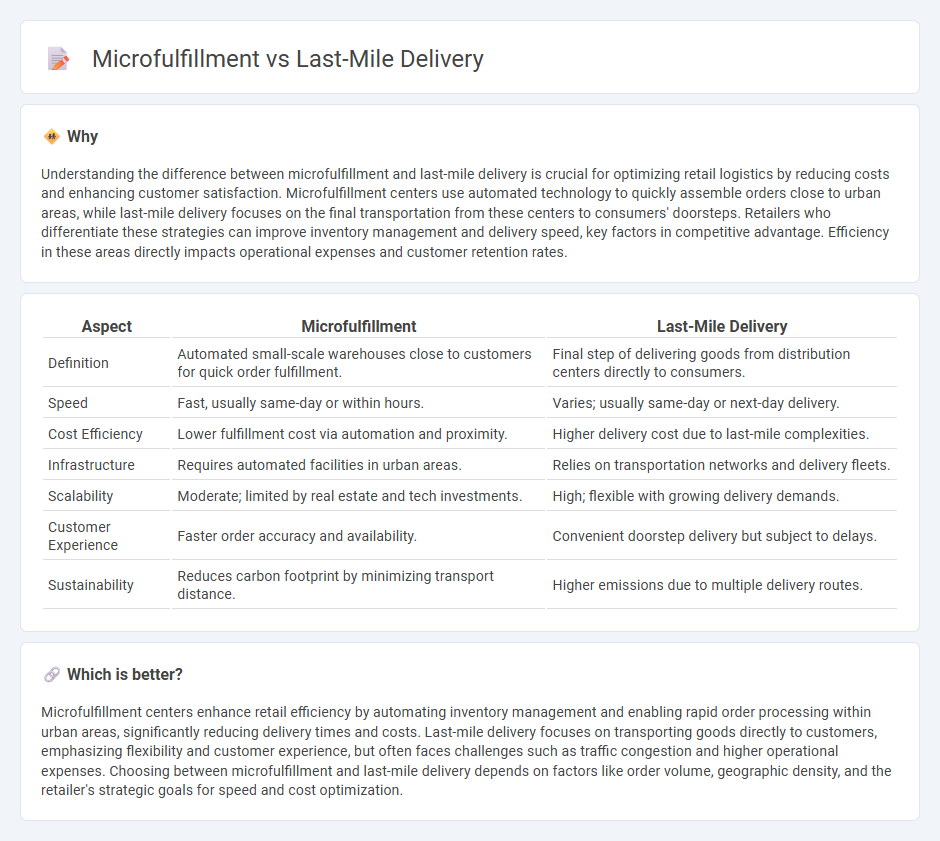
Microfulfillment centers leverage automated technology to store and pick products closer to urban areas, significantly reducing delivery times for retailers. Last-mile delivery focuses on the final step of the supply chain, transporting goods from distribution hubs directly to consumers' doorsteps, often addressing challenges like traffic and customer availability. Explore the benefits and challenges of microfulfillment versus last-mile delivery to optimize your retail logistics.
Why it is important
Understanding the difference between microfulfillment and last-mile delivery is crucial for optimizing retail logistics by reducing costs and enhancing customer satisfaction. Microfulfillment centers use automated technology to quickly assemble orders close to urban areas, while last-mile delivery focuses on the final transportation from these centers to consumers' doorsteps. Retailers who differentiate these strategies can improve inventory management and delivery speed, key factors in competitive advantage. Efficiency in these areas directly impacts operational expenses and customer retention rates.
Comparison Table
| Aspect | Microfulfillment | Last-Mile Delivery |
|---|---|---|
| Definition | Automated small-scale warehouses close to customers for quick order fulfillment. | Final step of delivering goods from distribution centers directly to consumers. |
| Speed | Fast, usually same-day or within hours. | Varies; usually same-day or next-day delivery. |
| Cost Efficiency | Lower fulfillment cost via automation and proximity. | Higher delivery cost due to last-mile complexities. |
| Infrastructure | Requires automated facilities in urban areas. | Relies on transportation networks and delivery fleets. |
| Scalability | Moderate; limited by real estate and tech investments. | High; flexible with growing delivery demands. |
| Customer Experience | Faster order accuracy and availability. | Convenient doorstep delivery but subject to delays. |
| Sustainability | Reduces carbon footprint by minimizing transport distance. | Higher emissions due to multiple delivery routes. |
Which is better?
Microfulfillment centers enhance retail efficiency by automating inventory management and enabling rapid order processing within urban areas, significantly reducing delivery times and costs. Last-mile delivery focuses on transporting goods directly to customers, emphasizing flexibility and customer experience, but often faces challenges such as traffic congestion and higher operational expenses. Choosing between microfulfillment and last-mile delivery depends on factors like order volume, geographic density, and the retailer's strategic goals for speed and cost optimization.
Connection
Microfulfillment centers enhance last-mile delivery efficiency by positioning inventory closer to urban consumers, reducing delivery times and transportation costs. These compact automated warehouses leverage robotics and AI to expedite order processing, enabling faster fulfillment of e-commerce demands. Integrating microfulfillment with last-mile logistics optimizes route planning, improves delivery reliability, and supports same-day delivery services in densely populated retail markets.
Key Terms
Order Fulfillment
Last-mile delivery optimizes the final shipment phase, ensuring fast, direct delivery to customers, crucial for enhancing order fulfillment speed and customer satisfaction. Microfulfillment centers leverage automated, localized warehouses to streamline inventory management and reduce delivery times, significantly impacting order accuracy and operational efficiency. Explore further the strategic benefits and technological advances in last-mile delivery and microfulfillment to elevate your order fulfillment process.
Urban Warehousing
Last-mile delivery and microfulfillment play critical roles in optimizing urban warehousing by enhancing speed and efficiency in dense metropolitan areas. Microfulfillment centers utilize automation and strategically located small warehouses to reduce delivery times and costs, while last-mile delivery ensures rapid, direct customer reach. Explore how these innovations transform urban logistics and customer satisfaction in smart city environments.
Delivery Speed
Last-mile delivery optimizes speed by directly transporting goods from local hubs to customers, reducing transit times and enabling faster order fulfillment. Microfulfillment centers strategically located within urban areas leverage automation to process and dispatch orders rapidly, minimizing delays commonly caused by centralized warehouses. Explore the differences in efficiency and implementation strategies between last-mile delivery and microfulfillment for enhanced delivery speed insights.
Source and External Links
Last mile delivery: solutions for your business - Last mile delivery is the final step of moving goods from a transportation hub to the end consumer, focusing on speed, cost, and quality, and is increasingly incorporating new methods like drones and autonomous robots.
What is Last Mile Delivery? Everything You Need to Know - Last mile delivery refers to the last phase of shipping where parcels move from transportation hubs to customers, involving critical steps such as order tracking, route optimization, and designated delivery personnel to ensure fast and efficient fulfillment.
Last Mile Delivery Explained: Trends, Challenges, Costs & More - The last mile is the final delivery stage from local warehouses to customers, significantly impacting customer satisfaction as this step directly reflects the brand's values and promise.
 dowidth.com
dowidth.com